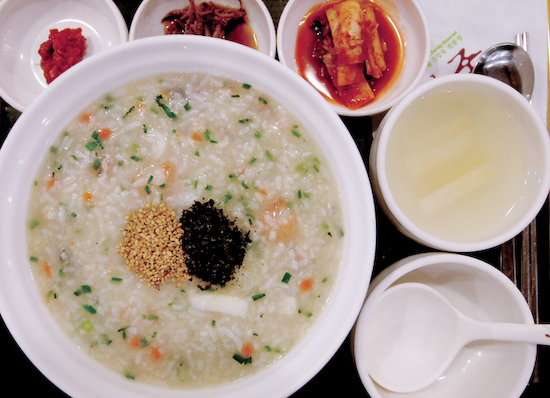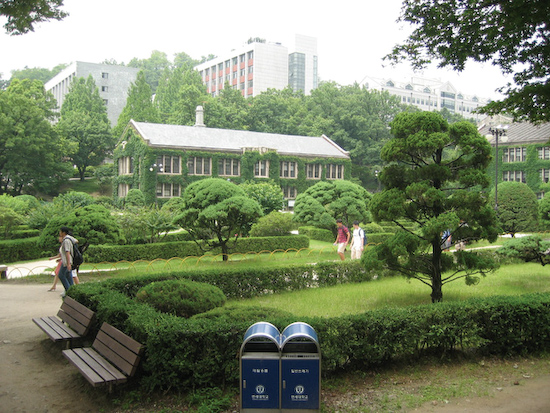By Christine Pae
Photographs by Eric Sueyoshi
A standard pot of juk is ordinary and rather plain fare for what it is: short-grain rice simmered in water until it becomes an opaque and glutinous porridge. Its flavor mirrors its lackluster appearance. All that stands out is a faint sweetness reminiscent of the sweetness of white bread.
But one restaurant franchise is knocking down what shortcomings there are in the bland-but-beloved porridge dish.
[ad#336]
Bonjuk, located in Los Angeles’ eatery-packed Koreatown, recognizes the value of serving juk exclusively. What was commonly known as “get-well” food has been redefined as a tasty, comforting dish laced with nostalgia for a mother’s love, making it worthy enough for folks to travel to a restaurantto get it.
Its success, says owner and manager Hyun Sook Kim, lies in its fresh and careful preparation. Each bowl of juk is prepared individually, never dished out from a vat, and enhanced with additional ingredients.
“A long time ago, juk was simple, with not as many ingredients and it wasn’t considered a healthful food,” Kim says. “But now, it’s better for your diet because of all the extra ingredients.”
The franchise boasts 700 locations in Korea, a couple in Japan and one that recently opened in Kuala Lumpur, Malaysia. In 2006, Bonjuk expanded overseas, making its first U.S. appearance in Los Angeles. Other locations in Garden Grove, Calif., Flushing, N.Y., and Las Vegas followed soon after.
Kim, 49, took over the Los Angeles branch in May 2007 and commutes from her home in Diamond Bar, Calif. every morning to help serve juk to what is becoming a diverse group of customers, 10 percent of whom are non-Korean, according to Kim.
[ad#336]
“They order in Korean and converse in English,” says Kim of the younger Korean American customers.
But a bowl of hearty juk from a restaurant comes with a price — a rather steep one, according to some online community restaurant reviewers who are fans of the place but admit that paying almost $30 for Bonjuk’s premium abalone juk is rather much. Lower-priced juk varieties range from $8 to $12.
“Bonjuk is not the place to go if you’re looking for culinary mastery or a bang-for-your-buck experience,” says Angela Taninies, a social worker from Torrance, Calif., who reviewed the restaurant on online city guide Yelp.com. “That being said, when it’s cold and rainy or I’m just feeling in dire need of comfort food, I know Bonjuk will offer me quality ingredients.”
The fresh ingredients are apparent in Bonjuk’s 17 varieties of juk, which include vegetable, beef and mushroom, ginseng chicken and sweet pumpkin. The dishes are topped with flavorful garnishes such as chopped scallions, carrots, ground sesame seeds and dried seaweed. Bonjuk’s most popular dish is the traditional abalone juk ($16) which adheres to juk’s standard simplicity made special with generous chunks of the shellfish.
Many customers are also attracted to Bonjuk for its distinctly Korean-style ambience and the appealing manner in which the juk is served, says Kim. The restaurant’s interior is clean and bright and follows a Korea-style décor. Dark wood accents contrast against pale, cream walls, shoes clack against a wooden floor.
When served, the juk arrives on individual black trays that also carry small dishes of kimchi, garlicky red chili sauce and jangjorreem, the shredded beef marinated in soy sauce and typically added in juk for flavor. The tray also comes with an extra bowl and a mini ladle to control helpings, while also adding a home-style touch.
Juk is just one of several renditions of rice porridge eaten in Asia, such as Japanese Okayu and Chinese congee, which unlike juk, is eaten usually at breakfast or for a late-night snack. One Bonjuk customer whose hometown is in Jakarta, Indonesia, says juk reminds her of bubur, an Indonesian version of rice porridge.
“We like all different kinds of porridge,” says Rosa Suprapto, a Cal State Northridge student studyingfinance. “[Bonjuk’s] has more ingredients and it’s more like comfort food.”
It all hits the spot for juk fans, who may or may not be fighting a cold or nursing a toothache.
“I have been guilty of nonsensical profligate spending on porridge,” Taninies says. “Yet I still refuse to do the same with something as simple as, say, a BLT.”
[ad#336]
Stir Some Up
At Home!
A recipe for abalone juk
Ingredients:
• 1-1/2 cups rice
• 1/2 cup pine nuts
• 6 cups water for soaking
• 1 can abalone (15 oz./425g), coarsely chopped, reserving the liquid for soup
• 5-1/2 cups water
• 1 piece leek, 2 inches long
Separately, soak the rice in 4-1/2 cups water and the pine nuts in 1-1/2 cups water for more than 2 hours, then drain. In a food processor, puree abalone liquid with the pine nuts. In a saucepan, bring rice and 5-1/2 cups water to a boil, then add the leek, abalone and the pine nut puree, and boil again for 3 minutes. Reduce heat and simmer 20 minutes.
Bonjuk locations
Los Angeles
3551 Wilshire Blvd.
(213) 380-2248
Orange County
10122 Garden Grove Blvd.
Garden Grove
(714) 534-0113
New York City
152-26 Northern Blvd.
(718) 939-5868
[ad#336]







